Wednesday, October 11
Saobi and Mir Ali, North Waziristan, Pakistan: Islamic guerrillas executed 2 men they accused of spying for US forces in Afghanistan here. A local doctor was found shot dead in Saobi and an Afghan was found in Mir Ali. Letters were found near the bodies warning others of a similar fate if they spied for the US. There have been a number of such killings in recent days.
Tuesday, October 10
Kabul: Bicycle bomb attack on a police bus here wounded 11 people, including both police and civilians.
Kandahar Province: Afghan police battled Taliban fighters near the wild border with Pakistan here. 2 police and 5 Taliban were killed in the fighting.
*****
Between the Wazokhaw and Dila Districts, Paktika Province: Taliban fighters abducted 3 employees of an Afghan construction firm here. News reports said they were abducted between the Wazokhaw and the Khoshawand Districts, but there is no Khoshawand District. Instead, Khoshomand, not Khoshowand, is the largest town in the Dila District. The dead body of one of the men has been found.
This area borders the Nawa District of Ghazni Province. We have not heard about much fighting in this area lately, but most of Paktika is dangerous for years now.
 The US base Orgun-E, located at Urgun, the main market town in northeastern Paktika near the Pakistani border. There has been a lot of fighting here for years now in these badlands. The Taliban fighters move easily across from North Waziristan across the border, which has now been taken over by the Taliban and Al Qaeda.
The US base Orgun-E, located at Urgun, the main market town in northeastern Paktika near the Pakistani border. There has been a lot of fighting here for years now in these badlands. The Taliban fighters move easily across from North Waziristan across the border, which has now been taken over by the Taliban and Al Qaeda.The barren terrain may not be normal. Like some other parts of Afghanistan, remote and underdeveloped Paktika has been badly deforested. This has resulted in predictable bad floods in parts of the province in recent years.
Monday, October 9
Garmser, Helmand Province: A US Air Force B-1B Lancer attacked Taliban fighters engaged with British forces near here. There seems to be fighting in this area every day now.
***
Myan Koh Mountain, Kajaki District, Helmand Province: US Air Force A-10 Thunderbolt IIs and U.S. Navy F/A-18 Hornets attacked Taliban fighters battling British troops near Myan Koh.There are several Myan Koh Mountains in Afghanistan, but this is probably the one that is being referred to.
It is located between Khum Bolagh (map here) and Ghulmesh (map here) in the northern part of the Kajaki District, about 10 1/2 miles west of the Uruzgan border. The area is about 20 1/2 miles north of Kajaki.
*****
Now Zad, Helmand Province: US Air Force A-10s and a B1-B and Navy F/A-18s attacked Taliban fighters battling British troops near here. There seems to be fighting almost every day near Now Zad.
Khogiani District, Nangarhar Province: Roadside bomb attack on a vehicle carrying Afghan officials killed the governor, the police chief and the head of security for this district. They were on their way to where fundamentalist morons had burned down a school earlier when the bomb hit.
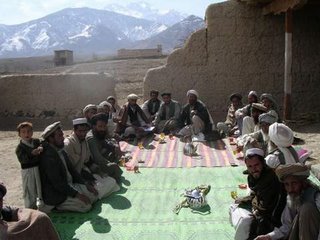 Breathtaking scenery from Nangarhar Province, near Jalalabad. This is some sort of a male gathering, possibly over tea, with soaring snow-capped peaks in the background.
Breathtaking scenery from Nangarhar Province, near Jalalabad. This is some sort of a male gathering, possibly over tea, with soaring snow-capped peaks in the background.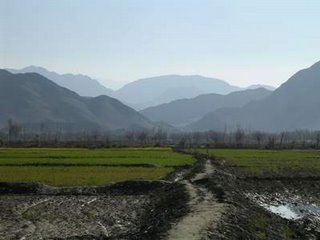 Another picturesque photo of Nangarhar Province near Jalalabad, with cultivated fields and rugged, forested peaks rising in the distance. Osama bin Laden lived near here, in a place called Farmada south of Jalalabad. Note that this province is substantially wetter and greener than much of the rest of Afghanistan.
Another picturesque photo of Nangarhar Province near Jalalabad, with cultivated fields and rugged, forested peaks rising in the distance. Osama bin Laden lived near here, in a place called Farmada south of Jalalabad. Note that this province is substantially wetter and greener than much of the rest of Afghanistan.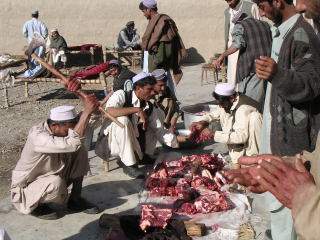 The Afghan men here in Jalalabad have just slaughtered an animal, apparently a goat, and are now butchering up the meat right out in the open for everyone to see. What seems to us as casual brutality is time-honored human tradition. Don't let PETA hear about this!
The Afghan men here in Jalalabad have just slaughtered an animal, apparently a goat, and are now butchering up the meat right out in the open for everyone to see. What seems to us as casual brutality is time-honored human tradition. Don't let PETA hear about this!Sunday, October 8
****
Cahar Cineh, Deh Rawood District, Uruzgan Province: Afghan and US forces battled the Taliban here and claimed to kill 52 Taliban, although independent confirmation was not available. There were 2 separate operations, one that reportedly killed 30 Taliban and another that reportedly killed 22 more Taliban. The fighting started when the Taliban ambushed US and Afghan forces.
News reports list this as the Charchino District, but there is no such thing. The nearest reasonable location is Cahar Cineh, which is 7 miles east of Deh Rawood and 9 miles east of Helmand Province. There is often very heavy fighting in this area, which is apparently a major Taliban stronghold. 2 Afghan soldiers were wounded in the fighting.
The Taliban rejected this assessment and said that instead, they lost 5 men and killed 20 Afghan soldiers.
*****
Madagal Sufla: Air Force A-10 Thunderbolt IIs attacked Taliban fighters who were battling British troops here. This town could not be located on any map.
7
Sangin, Helmand Province: French M-2000 Mirages attacked Taliban forces fighting British troops near here. There seems to be continuous fighting around Sangin. A riveting video of Canadian troops being ambushed in Sangin on August 6 of this year can be seen here. Check it out!
Now Zad, Helmand Province: U.S. Navy F/A-18 Hornets attacked Taliban fighters battling British troops again near here.
Saturday, October 7
****
Panjwayi District, Kandahar Province, Early AM: A Canadian soldier, Trooper Mark Andrew Wilson, was killed when the Taliban staged a small arms attack and set off a roadside bomb against a Canadian patrol near a NATO base.
Wilson was killed when his Nyala RG-31 armored vehicle was hit by a roadside bomb. The Nyala was damaged. The Nyala is a South African armored vehicle that is reportedly mine and roadside-bomb resistant, but I guess not.
The Panjwayi District is bisected by the Arghandab River, which forms a rich valley in Kandahar that is heavily irrigated and produces many crops, although the water is said to be brackish. The Arghandab is a 250 mile river that rises in the Hazara areas in Ghazni Province, flows down through Zabul Province and into Kandahar.
20 miles below Gereshk, it enters the Helmand River. The upper regions are not well-known. The valley formed by the Arghandab in Kandahar is most heavily populated and cultivated in the Panjwayi District, which is Taliban Central. Pomegranates, grapes and raisins are among the crops cultivated in this valley. There is a large dam on the Arghandab east of Kandahar, forming a lake called Arghandab Lake.
*****
Baghlan Province, Night: Unknown gunmen shot and killed two German journalists, a man and a woman, as they were traveling from Baghlan Province to Bamiyan Province. The 2 were working on a documentary. The Taliban denied that they killed the pair.
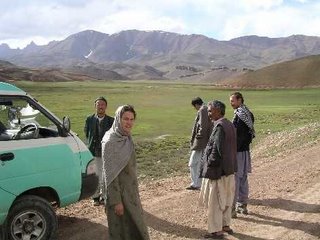 A photo of members of a relief agency in beautiful, remote and harsh Bamiyan Province, which is populated mostly by the Hazara, a persecuted Shia Muslim people with Asian features. Note the apparent Asian features of the woman.
A photo of members of a relief agency in beautiful, remote and harsh Bamiyan Province, which is populated mostly by the Hazara, a persecuted Shia Muslim people with Asian features. Note the apparent Asian features of the woman.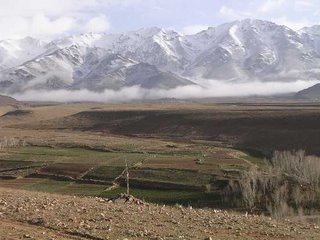 The gorgeous Koh-e Baba Range, a part of the Western Hindu Kush, on the border of Bamiyan and Vardak Provinces. Mountains here soar as high as 15,000 feet.
The gorgeous Koh-e Baba Range, a part of the Western Hindu Kush, on the border of Bamiyan and Vardak Provinces. Mountains here soar as high as 15,000 feet.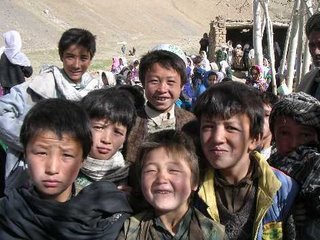 A photo of some obviously Hazara youth in Shinia, which is actually in northern Uruzgan near Bamiyan. Recently, in 2004, a brand new province was carved out of Uruzgan, lopping off the top half to form Daykundi Province, which is populated mostly by Hazara. Most people are not even aware that this province exists. Note the prominent Asian features of a number of these kids.
A photo of some obviously Hazara youth in Shinia, which is actually in northern Uruzgan near Bamiyan. Recently, in 2004, a brand new province was carved out of Uruzgan, lopping off the top half to form Daykundi Province, which is populated mostly by Hazara. Most people are not even aware that this province exists. Note the prominent Asian features of a number of these kids.Gereshk, Nahri Sarraj District, Helmand Province: A US Air Force B-1B attacked Taliban forces fighting British troops near here, where there is regular fighting.
Regay, Sangin District, Helmand Province: US Air Force A-10s, a B-1B, Navy F/A-18s and RAF GR-7s attacked Taliban forces fighting British troops here in this chronically dangerous area. The town was listed as Regal, but the actual name is Regay (map here). It is located 6 miles northeast of Sangin along the Helmand River.
Now Zad, Helmand Province: Once again, US Air Force A-10s and Navy F/A-18Cs attacked Taliban forces fighting British troops near here. There seems to be fighting around Now Zad every day now.
Kajaki 'Ulya, Kajaki District, Helmand Province: US A-10s attacked Taliban forces fighting British troops once again near here. There is very regular fighting around this town, which is located right below the Kajaki Dam.
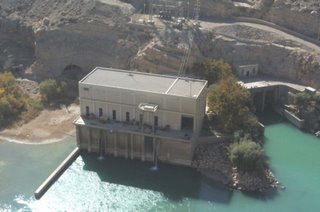 A photo of the powerhouse at the Kajaki Dam on the Helmand River in Helmand Province. This was one of the first targets attacked by US air power during the US invasion of 2001. This dam has reduced the amount of water flowing below it down the Helmand into Helmand Province and especially Nimroz Province, and in particular Sistan and Balochistan Provinces in Iran, where the Helmand empties into a marshy lake called Hamoun Lake.
A photo of the powerhouse at the Kajaki Dam on the Helmand River in Helmand Province. This was one of the first targets attacked by US air power during the US invasion of 2001. This dam has reduced the amount of water flowing below it down the Helmand into Helmand Province and especially Nimroz Province, and in particular Sistan and Balochistan Provinces in Iran, where the Helmand empties into a marshy lake called Hamoun Lake.As per a treaty signed between Iran and Afghanistan in 1972, Afghanistan was obligated to release 910 cubic feat of water per second out of the Kajaki Dam. The Taliban disgustingly violated this agreement during their time in power, with the result being that the Helmand was dry or virtually dry by the time it reached aforementioned provinces in Iran. This resulted in the death of cattle and wildlife in this part of Iran.
In late 2002, water began to reach Nimroz Province and Iran again. However, residents of Nimroz now claim that the Iranians are taking all of the water, and leaving the lower parts of Nimroz with none. The Hamoun Lake area in Iran is a rich biological area that appears to be suffering the typical result of water extractions in a desert region. Lately, the area around the Kajaki Dam is swarming with Taliban fighters and there are regular battles and air strikes in this area.
Paktika Province: US and Afghan troops battled the Taliban here, and 5 Taliban were killed and 1 more was captured. There was no word on Coalition casualties.
Paktika Province: Afghan troops battled the Taliban here and 1 Afghan soldier was killed. There were no further details.
Helmand Province: The Taliban fired on an Afghan army patrol from a moving vehicle here. There were no Afghan Army casualties, but 1 Taliban was killed when Afghan soldiers returned fire.
*****
Khost Province: A suicide car bomber attacked a US patrol near the Pakistani border, but only the bomber was killed. One US vehicle was damaged in the attack.
 A US Marine stands guard in Khost Province. His patrol was attacked shortly before this photo was taken. Note the snowy peaks rising in the distance.
A US Marine stands guard in Khost Province. His patrol was attacked shortly before this photo was taken. Note the snowy peaks rising in the distance.*****
Quetta, Pakistan: Police acting on a tip raided several Taliban hideouts here and arrested 48 Taliban who had recently arrived in small groups from Afghanistan. No important Taliban figures were arrested. Police were questioning them to determine why they were in Pakistan.
In order to arrest all the Taliban in Quetta, you would have to arrest about 1/2 the town. Quetta is Taliban Central, full of Afghans, and the non-Taliban look just like the Taliban.
*****
Friday, October 6
Now Zad, Helmand Province: Royal Air Force GR-7 Harriers attacked Taliban fighters near here once again in what seems to be a daily occurrence.
Kawre Ghar: An Air Force B-1B Lancer attacked Taliban forces fighting ISAF forces near here. This location could not be found on any map, but it is probably in Helmand Province, where most of the airstrikes are occurring these days.
Sangin, Helmand Province: A Royal Air Force GR-7 attacked Taliban forces fighting British troops near here once again.
Garmser, Helmand Province: A US Air Force B-1B attacked Taliban fighters battling British troops once again near here in this chronically unstable area.
Shenadan,Kunar Province: An Air Force B-1B attacked guerrillas fighting US forces near here. Shenadan (map here) is in the far north of Kunar, near the Nuristan border. Bari Kot and Arandu are located close by. There is an extremely dangerous area teeming with Taliban, Al Qaeda, Laskar-e Toiba, Hezb-i-Islami and other groups. Osama bin Laden was spotted at a wedding of one of his children near here in 2002.
Dabar: Navy F/A-18 Hornets attacked guerrillas fighting US troops near here. There are 2 Dabars, one in Khost and one in Ghazni. It was not specified which Dabar the bombing took place in.
Shurakian, Nahri Sarraj District, Helmand Province: US Air Force A-10 Thunderbolt IIs attacked Taliban forces fighting British troops near here. Sharakian (map here) is located 12 1/2 miles northeast of Gereshk along the Helmand River.
*****
Shami Chah, Washer District, Helmand Province: US Air Force A-10 Thunderbolt IIs attacked Taliban forces fighting British troops near here. Shami Chah (map here) is an unknown locale that is located between Sangilan (map here) and Tal Kala (map here) in the barren desert of the Washer District, heading out towards Nimruz Province.
It is located 16 1/2 miles south of Washer. This is near where the Taliban cut the Kandahar-Herat Highway at Dilaram in Nimruz Province not long ago.
*****
*****
Khost: A suicide bomber blew himself up outside a regional police headquarters here, killing himself and 1 officer, while wounding 3 more people.
 An outdoor girls' school in Khost. Although the teacher is male, not female, this is a great sign of progress in this ultraconservative region. George Bush is so cheap that he can't even spare the change to build a school for these poor girls, so their "school" is outdoors under a shade tree!
An outdoor girls' school in Khost. Although the teacher is male, not female, this is a great sign of progress in this ultraconservative region. George Bush is so cheap that he can't even spare the change to build a school for these poor girls, so their "school" is outdoors under a shade tree!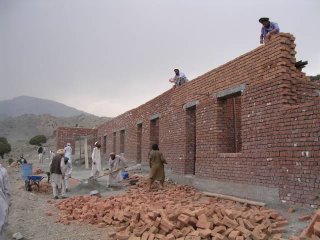 Afghan men constructing a brick building in Khost Province, in this lovely photo. I am not really sure what kind of building is being built here. Note the overcast skies - Khost receives a fair amount of rainfall. At the moment, Khost is very dangerous.
Afghan men constructing a brick building in Khost Province, in this lovely photo. I am not really sure what kind of building is being built here. Note the overcast skies - Khost receives a fair amount of rainfall. At the moment, Khost is very dangerous.*****
10 Miles Southeast of Khost: Another suicide bomber in a taxicab killed himself and wounded a taxi driver after police stopped to search the taxi at a checkpoint. The taxi was coming from Pakistan.
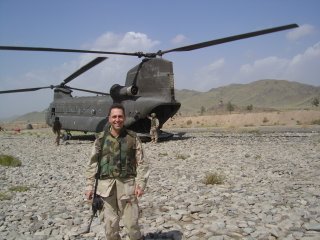 A US soldier after landing in a Chinook helicopter at a US base called Salerno in Khost Province. Note the stark, mountainous terrain of this Taliban-overrun province.
A US soldier after landing in a Chinook helicopter at a US base called Salerno in Khost Province. Note the stark, mountainous terrain of this Taliban-overrun province.*****
Dilaram District, Nimroz Province: Afghan police and the Taliban staged a battle here that went on for a while. 7 Taliban and 1 policeman were killed in the fighting, and 2 police were wounded. This is the first fighting I have heard of in Nimroz.
The Taliban definitely have a presence here in this part of Nimroz, where Helmand, Nimroz and Farah Provinces all come together. The parts of Farah and Helmand just across from Dilaram, in the far northeast corner of Nimroz, have also seen some activity lately. The adjacent part of Farah in the Gulistan District has seen hundreds of Taliban taking over district centers in the last few weeks.
The adjacent part of Helmand in the Washir District has seen some Coalition bombing. Other than the Dilaram District, the rest of Nimroz seems pretty calm.
*****
Near Balabolak, Balabolak District, Farah Province: The Taliban and Afghan police battled here in this unstable part of Farah Province. 4 Taliban and 1 policeman were killed in the fighting.
Arghandab District, Zabul Province: Roadside bomb attack killed 2 civilians and wounded 3 others. It was not known whether the civilians were meant to be targeted or whether the bomb went off by accident. This district adjoining Ghazni Province is fairly unstable these days.
Thursday, October 5
Orakzai Tribal Agency, Pakistan, Night: Feuding Sunni and Shi'ite Muslim tribesmen fired mortars at each other here, killing 17 people. The fighting was over a Muslim shrine Initially, Sunnis fired a mortar at Shia who were congregated at the shrine, killing 15 people. The Shia fired a mortar back, killing 2 Sunnis. There are weapons all over these tribal areas, mostly from the Soviet War.
Gelan District, Ghazni province: Police fired on a regional Taliban commander, Mullah Abdul Rahim Sabauun, and his bodyguard, who were riding on a motorcycle, killing both of them. Sabuun had been a high-ranking politician in the Taliban government. The Gelan District seems to be really falling apart these days.
Gereshk, Nahri Sarraj District, Helmand Province: US Air Force A-10 Thunderbolt IIs and British Royal Air Force GR-7 Harriers attacked Taliban fighters battling British troops near here. This area is seeing fighting almost every day with no end in sight now.
Qaryeh-ye Barang, Now Zad District, Helmand Province: A US Air Force B-1B Lancer and RAF GR-7s attacked Taliban fighters battling British troops near here. Qaryeh-ye Barang (map here) is located 13 miles south of Now Zad.
Cagay Ghar Mountain: RAF GR-7s and an Air Force B-1B attacked Taliban fighters battling British troops near here. The location was given as De Cagay Ghar, but no such place exists. Instead, Cagay Ghar is the name of several mountains in Afghanistan. It is not known which mountain is being referred to here.
*****
Garmabak, Maywand District, Kandahar Province: British RAF GR-7s attacked Taliban fighters battling NATO troops near here. Garmabak (map here) is located in the Maywand District of western Kandahar Province 11 miles northwest of the Kishk-e Nakhod, the capital of the district and 9 1/2 miles east of Helmand Province.
This region borders on the red-hot Gereshk region of Helmand, where there seems to be almost daily fighting these days.
*****
*****
Hesarak-e Sofla, Paktia Province: French M-2000 Mirages attacked Taliban fighters fighting US troops near here. Hesarak-e Sofla (map here) is located right next to Chamkani, the capital of the Chamkani District. The Chamkani District is in eastern Paktia, 11 miles from the Pakistani border. This area has not seen any fighting lately.
Tora Bora, where bin Laden made his last stand, is in the White Mountains 26 miles northeast of here. Across the border in Pakistan is Parachinar, where bin Laden and his group were sighted and spent the night after they crossed over into Pakistan in their escape from Tora Bora.
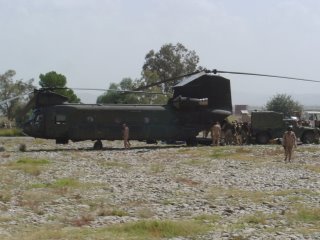 A Chinook helicopter lands at Gardez, the capital of Paktia Province. Paktia formerly included what is now Khost and Paktika Provinces, as such, it was a very large province. First Paktika was cleaved off, then later, after 2001, Khost was cleaved off. During the Communist regime, many of the top Communist militants, oddly enough, were Pashtuns from Paktia Province, which at the time included Paktika and Khost, as noted above.
A Chinook helicopter lands at Gardez, the capital of Paktia Province. Paktia formerly included what is now Khost and Paktika Provinces, as such, it was a very large province. First Paktika was cleaved off, then later, after 2001, Khost was cleaved off. During the Communist regime, many of the top Communist militants, oddly enough, were Pashtuns from Paktia Province, which at the time included Paktika and Khost, as noted above.That what seems now to be an ultra-conservative area was once the breeding ground for much of the Communist revolution in Afghanistan seems odd. But when one realizes that the Pashtuns have been running Afghanistan for a couple hundred years, and that tribal affiliations probably mean more than ideology, things start to make a bit more sense. In this manner a former Communist joins the Taliban with ease, strange as the transformation may seem.
Khayl-e Sufla: US Air Force B-1Bs attacked Taliban fighters battling international troops near here. This town, which is probably misspelled, could not be located on any map.
Armah, Paktia Province: US Air Force B-1Bs attacked Taliban fighters battling US troops near here. Armah (map here) is in the Zurmat District, 7 1/2 miles south of Zurmat, the capital of the district and 4 1/2 miles east of the Paktika border. There hasn't been any fighting around here lately.
Now Zad, Helmand Province: RAF GR-7s and U.S. Navy F/A-18 Hornets attacked Taliban fighters battling British troops near here, an area of continuous, daily conflict.
September 25
*****
Khost Province: The LA Times ran an article detailing how US soldiers stationed here tortured, beat and ultimately killed 2 Afghans in 2003 in the course of some fighting in the center of the province. I assume that George Bush's torture bill, which he recently pushed through Congress, allows this sort of thing, or not?
I am confused. Are the Taliban fighters who are fighting our troops in Afghanistan "terrorists" or "enemy combatants" who are to be denied the rights of POW's under the Geneva Conventions? The recent fuss over Bush's "compromise" with Congress on the torture bill he was trying to ram through Congress was dishonestly reported by the disgusting US media.
The "program" that Bush was "threatening to stop" had already been stopped for 9 months. That program was a project to torture, beat and abuse POW's who we deem terrorists.
This subject is terribly confused and most folks do not understand it at all.
First of all, let us note that according to international law, people in wartime are, in general, either civilians or combatants. Combatants in general are entitled to POW status.
If you feel that a combatant is guilty of plotting terrorist attacks against your civilians on the home turf, I suppose you need to charge them with criminal charges and then give them criminal trials on charges of terrorism. If they are merely combatants fighting your troops, they are just POW's. If not, they are non-combatants or civilians, who are also entitled to protection.
It is difficult to foresee a case where enemy combatants who are attacking your soldiers in wartime could possibly be seen as terrorists. Any enemy combatant attacking your troops in wartime is a POW, no two ways about it, and they are entitled to the full protections of the Geneva Conventions for war prisoners. Thing is, Bush does not want to grant POW status to enemy combatants!
So he has redefined a number of them as "illegal combatants", which is a nonsensical phrase that has no meaning in international law. No meaning! Furthermore, Bush is too chickenshit to charge the actual terrorists (such as Khalid Sheik Mohammad, who could be charged with the 9-11 attacks) with terrorism charges and then try them before a criminal court.
Why not? Even Israel routinely tries Palestinians on terrorism charges in criminal court, where they receive all the protections of any other criminals. If it is good enough for the Zionist regime, surely it is good enough for the US? Because Bush feels that in many cases, he lacks the evidence to convict them in criminal court, that's why!
Very well, then! In that case, call em POW's and sock em away until the end of the war. Since Bush does not want to treat them as POW's and furthermore does want to try them as terrorists in criminal court, Bush has come up with a third alternative. To define them with the fake term "illegal combatants" and try the "terrorists" (Who are they, again?) before military tribunals in what amounts to grossly unfair kangaroo courts.
There is little or no precedent in our history for such fake trials, which are like the fake trials one sees in dictatorships. Those who support Bush's military tribunals need to come clean and admit that these will be outrageously unfair kangaroo courts in which the possibility of a fair trial is foregone.
Also, in the course of these fake trials before hanging judges, Bush says he needs to keep the evidence against the terrorists in these tribunals secret, which is another reason they cannot try the terrorists in criminal court. The evidence is so deadly secret that to reveal it in court would compromise national security.
Yet the Israelis do not seem to have this problem, and surely the Israelis deal with rank terrorism against their citizens on a virtual daily basis, as opposed to the US, where there has not been a serious terrorist act on our soil in years. If it's good enough for the Israelis, who are much more at risk than we are, why is it not good enough for us?
In another aspect of this fake "compromise", Bush won the right to get rid of Habeas Corpus, an essential part of US law that dates back to the Magna Carta in the 1200's. The US Constitution says that Habeas Corpus may be ended only in the case of invasion or rebellion, neither of which is occurring.
It is true that Abe Lincoln got rid of Habeas Corpus during the Civil War, but he made it clear that this was simply an emergency act during extraordinary times, and it was immediately reinstated after the War. Even Lincoln's act was questionable.
Yet Bush has apparently gotten rid of Habeas Corpus for the duration of the Terror War, which is apparently going to last forever! Not only that, but all Presidents coming after Bush will also be able to circumvent Habeas Corpus. The implications here are just stunning and I urge readers to sit down and think about this really hard.
What is Habeas Corpus? It means that you cannot be imprisoned on no charges. Within 48 hours, you have to be charged with a crime, otherwise the authorities need to release you if they lack the evidence to charge you with a crime. Dictatorships routinely get rid of Habeas Corpus as one of their first acts, and people in dictatorships routinely cool their heels for years in prison with no charges being filed at all.
Another bad thing about getting rid of Habeas Corpus is that now we will have no way to determine if the people Bush says are terrorists really are terrorists, or are just guerrillas fighting our soldiers in Iraq and Afghanistan, or just innocent people swept up in Afghanistan, because there will be no way to challenge their detention before a court.
Do you see how what Bush has done is sending the US down the road to dictatorship (and I do not exaggerate)? Furthermore, Bush is going to try people who do not even have the right to see the evidence against them! Can you imagine being tried for murder, with a possible death sentence, and you cannot even see the evidence against you? The evidence is secret! This is almost comical if it were not so terrifying.
Dictatorships also typically use secret evidence to convict people - this is another hallmark. Oh well, you say, we will only use these dictatorship-like tactics against terrorists. Fine. But who is a terrorist? Anyone Bush (or any subsequent President) says is a terrorist! He gets to define the term. Once again, this is almost risible if it were not so scary.
This whole debate was shot through with the most rank, despicable dishonesty brought to you straight from the vile US media. According to the "compromise", Bush will not engage in torture or abuse prisoners. But Bush said he never tortured or abused any prisoners anyway! What were they doing to them? Well, it involved "harsh interrogations", but it was not torture or abuse, even when the prisoners died of it!
However, according to the terms of the lofty "compromise" hailed by the filthy media, Bush will be able to do quite a bit of torturing and abusing of prisoners; he will just be able to redefine it as "non-torture" and "non-abuse".
The stinking media croons that the terms of the "compromise" means that the US will continue to uphold the Geneva Conventions as far as torture and abuse of prisoners, but Bush gets to define for himself what he thinks the Conventions mean!
The reason Bush needs to redefine for himself what the Conventions actually mean is because he insists that the Article in question is "vague". What is interesting is that no previous US President has ever felt that this particular Article was vague. It says you can't torture people. What's so vague about that. I am laughing as I write this. This "compromise" was clearly nothing but.
The whole debate, if one bothered to dip into it (as I did) was conducted entirely on a lawyerly basis. Even most of the legal minds involved did not appear to understand the meaning of the final compromise. If the lawyers can't even figure it out, how can the average 100 IQ citizen?
I realize that I went on a bit here, but I think this is a very important issue that all Americans should be aware of. If, after reading the above, you feel the US should head down the road to dictatorship, fine. If not, I feel you need to think really hard about exactly what Bush and the Congress have just done with this torture nonsense.
My description above tells you more about this issue than hours of TV News will ever tell you. Make up your mind one way or the other, but at least understand what is being negotiated here. By the way, Glenn Greenwald's blog, Unclaimed Territory , is an excellent source for all of the above, and Bush's illegal authoritarian madness in general. Greenwald is a Washington attorney, but the arguments are pretty easy to follow.
*****

No comments:
Post a Comment